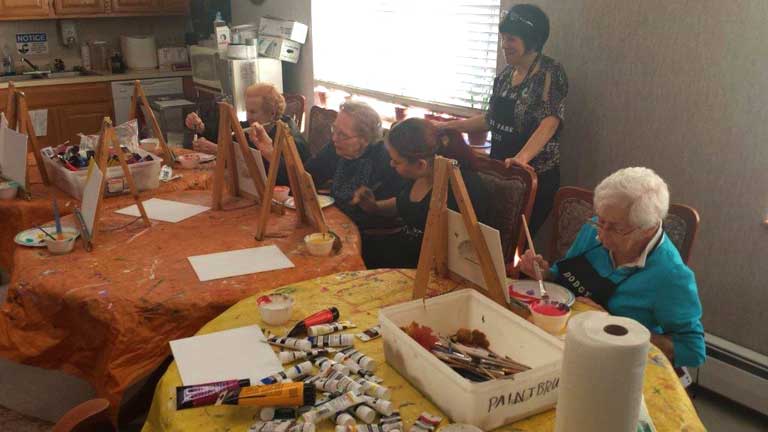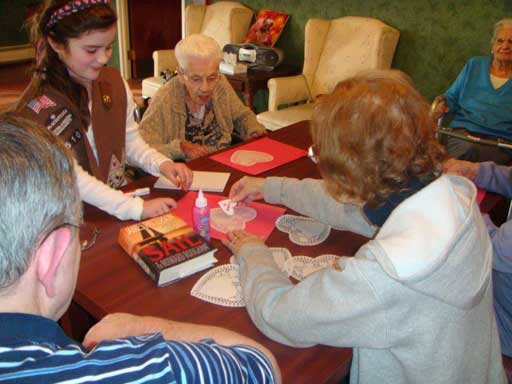
Art offers all people the opportunity to express themselves creatively and emotionally. It can bring moments of meaningful engagement. Everyone needs these connections to live life to their fullest capability. Individuals living with Alzheimer’s and other forms of dementia are no exception.
Many seniors are socially isolated. Art is a way for them to connect with the world, giving them opportunities to feel a sense of belonging. It creates the perfect time for them to tell their personal stories and reminisce. Family members creating art alongside their senior loved ones gives them the confidence to get started and keep at it.
Caregivers can connect using eye contact, touch, and a soothing voice. Husband and wife can interact on a more normal level, celebrating their relationship, rather than as care partner and a person with dementia. Especially in difficult relationships, creating together makes it easier to express a genuine caring and show an interest in each other.
Creating Art Can Delay Cognitive Decline
For seniors, creating visual art and music can distract them from their physical pain and stimulate their cognitive faculties. A growing body of evidence shows that creativity improves physical and psychological health.
A German study from the University Hospital Erlangen shows creating art could delay or negate age-related decline in some brain functions, such as Alzheimer’s and dementia-damaged portions of the brain responsible for memory and multi-step tasks, according to researchers Anne Bolwerk and Christian Maihöfner. The part of the brain that involves emotion and creative understanding remains functioning for much longer. The memory fades, but the imagination can expand, even as people grow older, the researchers say.
Changing How Alzheimer’s Disease Is Viewed
In the international documentary film, “I Remember Better When I Paint: Treating Alzheimer’s Through the Creative Arts,” writers/directors Eric Ellena and Berna Huebner show the positive impact of art and other creative therapies in people with Alzheimer’s disease and how these approaches can change the way the disease is viewed by society. Narrated by Olivia de Havilland, the film examines the way creative arts bypass the limitations of dementia disorders and illustrates how patients’ still-vibrant imaginations strengthen through therapeutic art.
The film brings encouragement and hope for caregivers and those with the disease. One of several noted doctors in the film, Robert Green, MD, professor of neurology and genetics at Boston University, said, “Alzheimer’s disease doesn’t affect the entire brain all at once. It seems to selectively start in the parts of the brain that are important for laying down new memory.”
Delving deeper into the findings, Sam Gandy, MD, associate director of Mt. Sinai Alzheimer’s Disease Research Center in New York City, said in the film, “There are parts of the brain that are involved much later that are really involved in creativity. … The parietal lobe is stimulated through creative activities like art and music.”
Added Judy Holstein, director at CJE Senior Life Day Service in Chicago, “The creative arts are an avenue to tap into a nonverbal, emotional place in a person. When they are given any kind of media for art making, and their hands are involved and their muscles are involved, things are tapped in them that are … active and alive. So, creative arts bypass the limitations,” she said.
“People still have imaginations intact, all the way to the very, very end of their progressive disease.”
Benefits Are Immeasurable
“Art is a great way to express feelings and emotion,” says Micha Shalev, MHA, CDP, CDCM, owner and executive director of Dodge Park Rest Home in Worcester, Mass.

“It is amazing what residents that no longer remember their loved ones can do. I see residents with advanced dementia who typically experience pain when sitting for long intervals but can now sit for hours and paint,” he says. “It is a form of relaxation for them. It also helps them with coordination, socialization, reflexes, and is even a form of low-grade exercise.” Shalev is author of the 2014 book, “A Practical Guide for Alzheimer’s and Dementia.”
In 2007, the Museum of Modern Art in New York started a special Alzheimer’s initiative, Meet Me at MoMA.
Funded by the MetLife Foundation, MoMA expanded on its existing education programs from 2007 to 2014 for those with Alzheimer’s disease and their caregivers. Providing training resources for art and health professionals, the museum’s goal has been to help organizations and communities make art accessible to individuals with dementia.
To any organization that is interested in making art accessible to people with dementia, MoMA will provide advice and resources to facilitate training workshops locally, nationally, and abroad.
Smashing The Stereotype
An inspiration is healthy and robust 89-year-old artist Harold Garde. After 50 years of painting, his creative process is stronger and better than ever. In Marc Middleton’s “Growing Bolder” interview, art curator Jeanne Dowis said, “with every new painting, Garde smashes the stereotype that aging is a time of loss and regret. There are many people that are doing their finest work when they get into their 70s and 80s.”
In art, there is no right or wrong. There is a benefit to any amount of engagement, at any level.
Researchers know that creativity enhances the quality of life at every stage in human development. Creative opportunities result in increased curiosity and personal growth.
The goal of providing opportunities to be creative is to enable those living with dementia to maintain and enhance their quality of life and to use their remaining abilities to express themselves, when words may no longer be possible.
Tips To Get Started
Creative projects should be experienced often and incorporated into daily activities.
When planning an art activity for someone with middle- to late-stage Alzheimer’s, here are a few tips adapted from the Alzheimer’s Association:
■ Keep the project on an adult level, avoiding anything that might seem childlike.
■ Build conversation into the project, providing encouragement. Discuss what the person is creating or reminisce.
■ Help the person begin the activity. If painting, the leader may need to start the brush movement.
■ Use safe materials. Avoid toxic substances and sharp tools.
■ Allow plenty of time. The person does not have to finish the project in one sitting.
Remember, everyone has the power to heal by sharing creativity. Art, sharing, and healing are interwoven. Art is the catalyst!
Barbara Balkin is founder and owner/artist of both Back Gate Studio and Artkin in Boise, Idaho. Artkin helps build connections through creating art with family and friends—joining people together to create an original group art canvas to be treasured for generations—an innovative activity for celebrations, events, team building for business, and fundraisers. She can be reached at barbara@myartkin.com.
For More Information
With the increasing interest in art for people with Alzheimer’s and dementia, learn more about the benefits of creativity for seniors at: